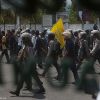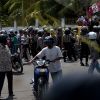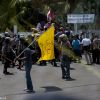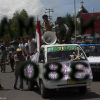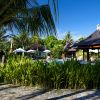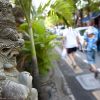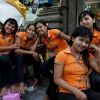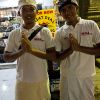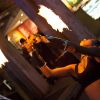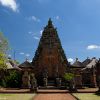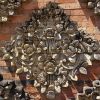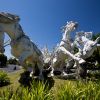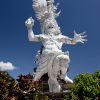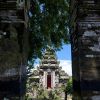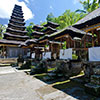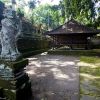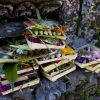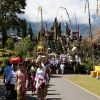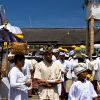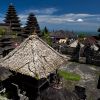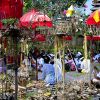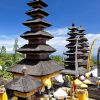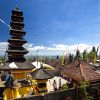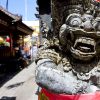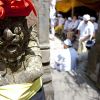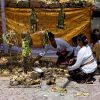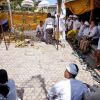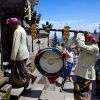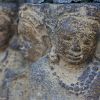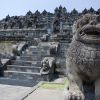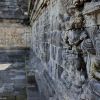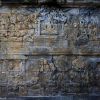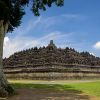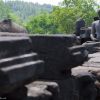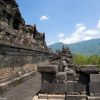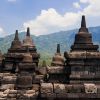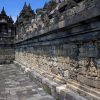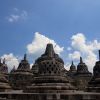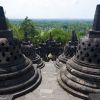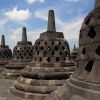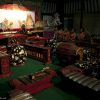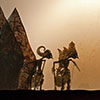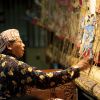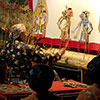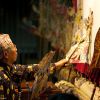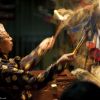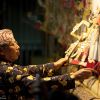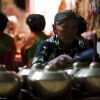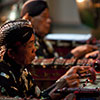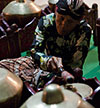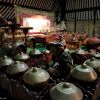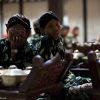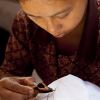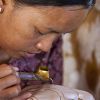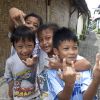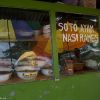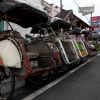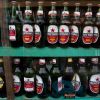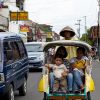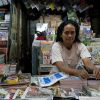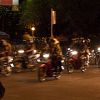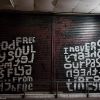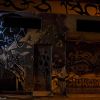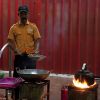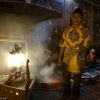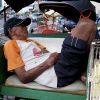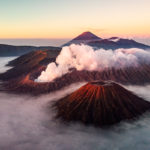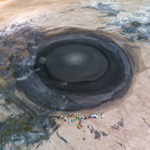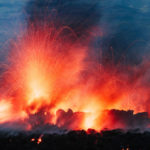From Starting in Ende to Ending in Jakarta – Travelling the Sunda Islands
The town of Ende sounds like the final of a trip, but can also be quite a good start for travelling the Indonesian Sunda Islands eastwards, all the way to Jakarta. On the way to Indonesia’s capital you’ll surely experience plenty of possibilities to get in touch with the most diverse people plus look behind the scenes of illustrious names like Bali or Komodo. Indonesia, that also stands for volcanoes, earth quakes and tsunamis. At first glance that doesn’t sound all too well, but who knows, maybe the creative hand of volcanoes’ was active again when giving birth to unique things of culture like artful batik, huge religious temples or filigree old Indonesian shadow puppetry.
Topographically seen Flores is one of the most spectacular Sunda Islands. On that volcanically formed island roads are curling between giant strato volcanoes being up to 2000 meters high. Flores is definitely one of the best places to experience Indonesian life and meet authentic people. Additionally it is a very inexpensive place: for a 1.5kg grilled freshly caught lobster you only pay 150.000 rupees (13 US$) and it costs only 11.000 rupees (~90 US$ cents) to get an extra fantastic seafood soup on top.
Whether it’s about Nasi Goreng, Nasi Campur or Nasi Soto Ayan – Nasi means steamed rice and it is the basic ingredient for many Indonesian dishes. Culinarily seen I had the best food on Flores, as their way of food preparation met my expectations of spice usage and freshness best. Without hesitation you can trust your nose, which will surely lead you to some of the small Warungs selling food on the streets.
In terms of political affairs Indonesia is not too far away from for example Germany. Who does really care when Springer-esque jubilation press is heralding the hundred year Chancellorette again? Similar like in Germany different-minded people get categorised as dangerous to democracy and it doesn’t take much time until the truncheon-wielding riot police shows up, as shown here on the photos taken in Ende.
To some extent Bali is Australia’s adjacent recreational area. The south of the island mainly stands for all things connected to beach life. Doesn’t matter if it’s about surfing, grilling yourself in the sun or just swimming, Kuta & Co. will provide you a pleasant time. Regarding Balinese nightlife Kuta’s Legian Street will surely give you a whole new experience, as not only dancing the night away is on the bill, but also 60 year old Dutch hunting for 16 year old chicks… On the other side men travelling alone will surely be chased by the local hookers. By the way, the Legian Street was scene of the bombings that happened on October 12th, 2002.
People on Flores have Christian roots, Java is trough and trough Muslim and Bali is Hindu. Either way, in Indonesia religion is a very important topic. There is even a law regulating that an Indonesian citizen has to be a member of one of the five world religions. Unfortunately Bali is quite enjoying draining the cup of all things called religion, as they unveil their religious side only for cash. Hence interested tourists have to pay everywhere when having a closer look at temples. Sometimes Balinese people keep an eye that you’ll get only a glimpse of their temples.
At Pura Besakih (the Mother Temple) that is most clearly discernible. Literally within some minutes only you get pushed through the large labyrinthine temple complex, having no real chance to rest and to have a look at things going on. To boot I noticed an attitude that considers Muslims inferior. When I remember the very hospitable Muslims in Damascus, then they took me by the hand and explained their religion to me. They felt a need to show me their mosques and celebration and nobody turned up to cash in… People selling their religion are behaving and acting contrary to the God they are praying to.
The same unfortunately also applies to the Borobudur temple near Yogyakarta. In about 1 hour public buses take you from Yogya to that UNESCO World Heritage. Locals pay an admission fee of 12.000 rupees, while white tourists have to fork out the tenth, which is 120.000 rupees. How was that central idea of almost all religions called? All humans are equal before God? Well, somehow a government has to be financed. To me the western money doesn’t really seem to flow into preserving the temple.
On the other hand tourists’ money is used to make the Brobodur campus being a stage for an exhibition, where you can see world records, like the farmer with the biggest lemons or the greatest idiot managing to eat the most cockroaches alive… The clause that you have to give off your water bottles is quite a hassle, as the sun is burning down on the shadowless temple without batting an eye.
Yogyakarta is more than only a starting point for the day trips to the temples of Brobodur and Prambanan. The city itself is quite lovely, especially the Kraton, which is the still used palace of the Sultan. In one of its dependences the tradition of old Indonesian shadow puppetry is cultivated. On special occasion tourists may attend to such evenings and even if you don’t understand Indonesian, having a look at the filigree carved wooden stage screen and watching things behind the scenes is quite a pleasure.
Yogyakarta is THE hot spot for all things called batik. Dermo, the director of the batik institute would have loved to put my photo in a golden frame and invest me as Customer of the Year, as I left his institute having spent not less than 600 Euros; of course I got unique filigree batiks for that. When buying batiks on the streets you can get poor quality for the same money. Dermo is really proud that his quality batiks don’t lose their colours when becoming washed or ironed. Depending on motif and size, creating such a batik can take up to 6 months of work. Against the background of European prices such handwork is unaffordable. The batik is unfolding its full potential when light shines through. Whether it is made of cotton or silk, when background light comes into affairs, then the colour will make your jaw drop.
In terms of food it is like on Flores: you can trust your senses and can follow your nose without hesitation. In the evening hours it will surely guide you to one of the small mobile food stalls, where some Chicken Sate (spits) get roasted on a mini charcoal grill. As for traffic and public transportation Yogya is a hub as well. In addition to an army of busses departing to places actually all over Java, you also have access to the railroad system. For example you can easily travel to Jakarta, which is just an 8 hour over night ride away. But watch out: on trains the air-condition is running at full throttle. When arriving to smog and sewer holes like Jakarta, then you can literally wait for the first sick feeling or even fever attack.
It seems to be my fate that brilliant travels always end on a dump. In West Africa it was Serekunda, when travelling through Arabia Cairo undertook that task and now in South-East Asia it was up to Jakarta. Being penetrated by open sewers and flooded with smog, Jakarta’s thousands and thousands of air-cons are transporting diseases within seconds. If large-scale skin irritations or even fever attacks, everything is possible. And needing about 2.5 hours to drive 30km from the city centre to the airport is surely also unique world-wide…
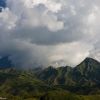
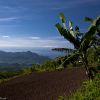
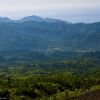
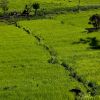
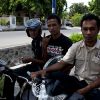
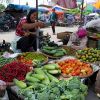
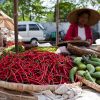
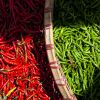

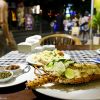
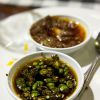

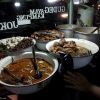

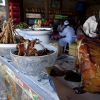
![[Phone Photo] - Absolutely tasty Nasi Soto Ayam, with Glass Noodles and Peanuts](https://www.xflow.eu/wp-content/thumb-cache/6a9cfdbf7fc67d1be86a235dfacaf00f.jpg)
![[Phone Photo] Chicken marinated in Chilli Paste, beside Rice and fresh Mint Leafs](https://www.xflow.eu/wp-content/thumb-cache/97f8173123f1b9f8de51852016ebcee0.jpg)
![[Phone Photo] Nasi Soto Ayam a different Way...](https://www.xflow.eu/wp-content/thumb-cache/2f122ca75bebc00f1782f6f123973824.jpg)
![[Phone Photo] Big Noodle Soup, beside Chicken Sate](https://www.xflow.eu/wp-content/thumb-cache/f297cf64475bdaf08da1a79171368246.jpg)
![[Phone Photo] Also Fans of Noodle Dishes will find their El Dorado in Indonesia](https://www.xflow.eu/wp-content/thumb-cache/3534d0c3cbc89429fadf047e1e123045.jpg)
